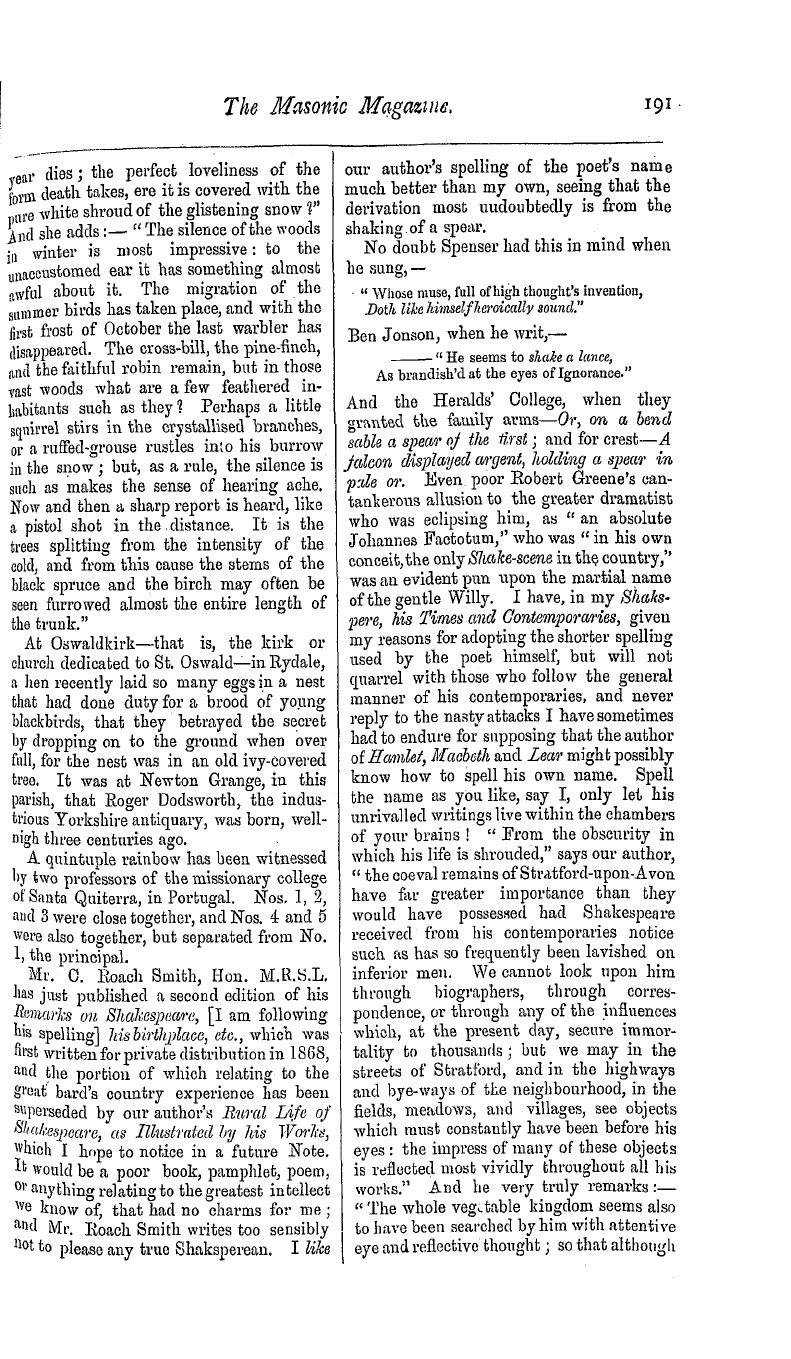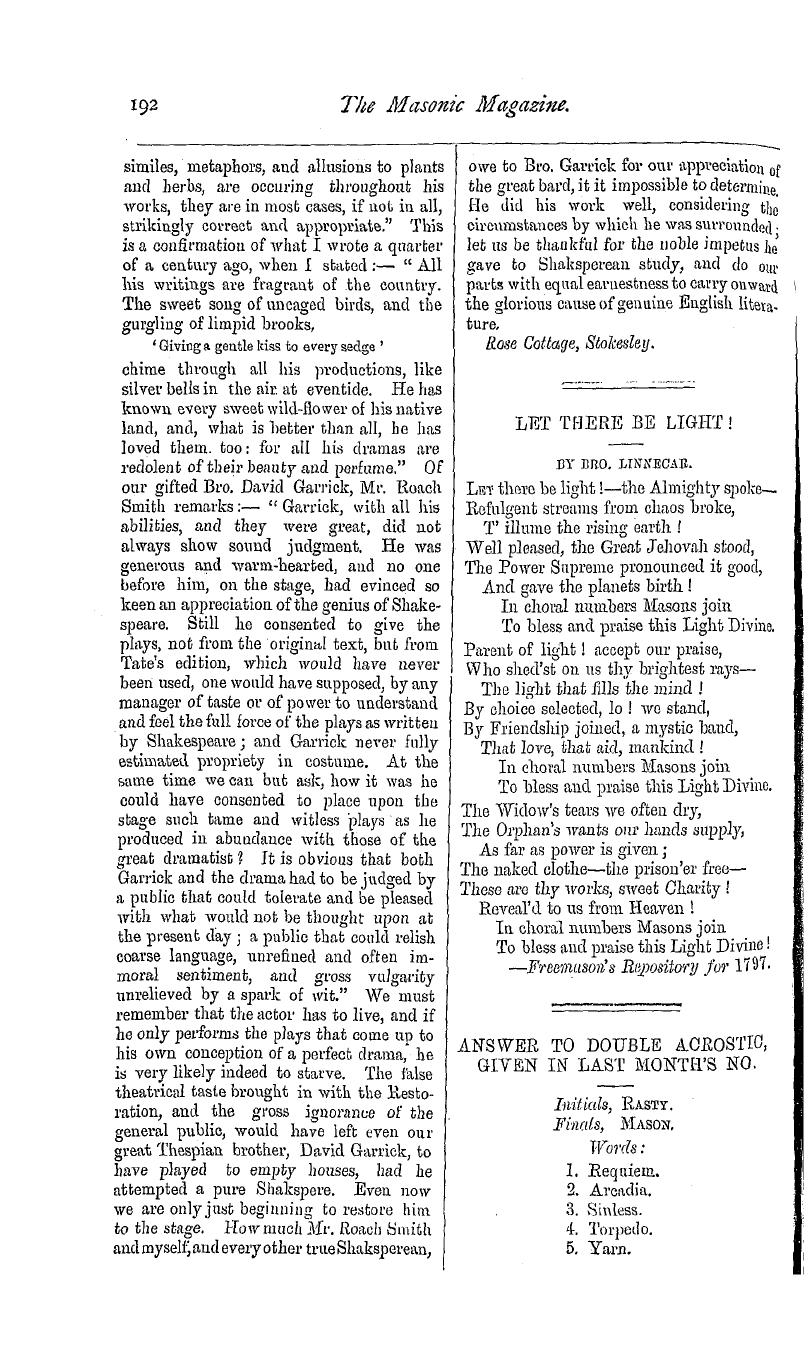Note: This text has been automatically extracted via Optical Character Recognition (OCR) software.
Objects, Advantages, And Pleasures Of Science.
and of art . Experiments of a simple and decisive nature show the amount of its pressure to be between 14 and 15 pounds on every square inch ; but , like all other fluids , it presses equally in every direction , so that though , on one hand , there is a pressure downwards of above 250 pounds
, yet this is exactly balanced by an equal pressure upwards , from the air pressing round and getting below . If , however , the air on one side be removed , the whole pressure from the other acts unbalanced . Hence the ascent of water in pumps
, which suck out the air from a barrel , and allow the pressure upon the water to force it up 32 or 33 feet , that body of water being equal to the wei ght of the atmosphere . Hence the ascent of the mercury
in the barometer is onl y 28 or 29 inches , mercury being between 13 or 14 times heavier than water . Hence , too , the motion of the steam-engine ; the piston of which , until the direct force of steam was applied , used to be pressed downwards by the
weight of the atmosphere from above , all air being removed below it by first filling it with steam , and then suddenly cooling and converting that steam into water , so as to leave nothing in the space it had occupied . Hence , too , the power which
some animals possess of walking along the perpendicular surfaces of walls , and even the ceilings of rooms , by squeezing out the air between the inside of their feec and the wall , and thus being supported by the pressure of the air against the outside of their feet .
The science of Optics ( from the Greek word for seeing ) , which teaches the nature of li ght , and of the sensation conveyed by it , presents , of itself , a field of unbounded extent and interest . Newton made the astounding discovery that a beam of li
ght which we call white , is composed of all the colours blended in certain proportion ; he caused a ray of light to pass through a prism of glass , and thus he anal yzed the beam by showing the spectrum on a screen beyond . Since that time the
marvellous instrument called the Spectrosoo pe has been invented , which goes one s 'ep further inasmuch as it analyzes the spectrum , showing that each colour contews more or less dark or light lines dependant upon the materials inflamed to Produce the illumination . The value of
the discovei'ies which continue to be made with the Spectroscope it is impossible to estimate . To a man who , for original genius aud strong natural sense , is not unworthy of being named after this illustrious sage , we owe the greater part of Electrical
science . It treats of the peculiar substance , resembling both light and heat , which , by rubbing , is found to be produced in a certain class of bodies , as glass , wax , silk , amber ; and to be conveyed easily or conducted throughvothersas woodmetals
, , , water ; aud it has received the name of Electricity , from the Greek word for amber . Dr . Franklin discovered that this is the same matter which , when collected in the clouds , and conveyed from them to the Earth , we call lightning , and whose
noise , in darting through the air , is thunder . From the time of . Franklin Electricity has been studied and experimented upon by scientific men in all parts , and the results have been overwhelmingly successful , in fact they may be said to have revolutionized the whole world b y the invention of the Electric Telegraph . Step by step improvements still continue
to be effected , and it seems that the wonders to be accomplished in this branch of science must be unlimited . The observation of some movements in the limbs of a dead frog , gave rise to the discovery of Animal Electricity or Galvanism , as it was at first called from the name of
the discoverer ; and since which has given birth to improvements that have changed the face of chemical philosophy ; affording a new proof how few there- are of the processes of nature incapable of repaying the labour bestowed in patientl
y and diligently examining them . In order to explain the nature and objects of those branches of Natural Science more or less connected with the mathematics some details were necessary , as without them it was difficult immediately to
perceive their importance , and , as it were , relish the kind of instruction which they afford . But the same course need not be pursued with respect to the other branches . The value and interest of chemistry is at once perceived , when it is known to teach the nature of all bodies ; the relations of simple substances to heat and to one another , or their combinations together
Note: This text has been automatically extracted via Optical Character Recognition (OCR) software.
Objects, Advantages, And Pleasures Of Science.
and of art . Experiments of a simple and decisive nature show the amount of its pressure to be between 14 and 15 pounds on every square inch ; but , like all other fluids , it presses equally in every direction , so that though , on one hand , there is a pressure downwards of above 250 pounds
, yet this is exactly balanced by an equal pressure upwards , from the air pressing round and getting below . If , however , the air on one side be removed , the whole pressure from the other acts unbalanced . Hence the ascent of water in pumps
, which suck out the air from a barrel , and allow the pressure upon the water to force it up 32 or 33 feet , that body of water being equal to the wei ght of the atmosphere . Hence the ascent of the mercury
in the barometer is onl y 28 or 29 inches , mercury being between 13 or 14 times heavier than water . Hence , too , the motion of the steam-engine ; the piston of which , until the direct force of steam was applied , used to be pressed downwards by the
weight of the atmosphere from above , all air being removed below it by first filling it with steam , and then suddenly cooling and converting that steam into water , so as to leave nothing in the space it had occupied . Hence , too , the power which
some animals possess of walking along the perpendicular surfaces of walls , and even the ceilings of rooms , by squeezing out the air between the inside of their feec and the wall , and thus being supported by the pressure of the air against the outside of their feet .
The science of Optics ( from the Greek word for seeing ) , which teaches the nature of li ght , and of the sensation conveyed by it , presents , of itself , a field of unbounded extent and interest . Newton made the astounding discovery that a beam of li
ght which we call white , is composed of all the colours blended in certain proportion ; he caused a ray of light to pass through a prism of glass , and thus he anal yzed the beam by showing the spectrum on a screen beyond . Since that time the
marvellous instrument called the Spectrosoo pe has been invented , which goes one s 'ep further inasmuch as it analyzes the spectrum , showing that each colour contews more or less dark or light lines dependant upon the materials inflamed to Produce the illumination . The value of
the discovei'ies which continue to be made with the Spectroscope it is impossible to estimate . To a man who , for original genius aud strong natural sense , is not unworthy of being named after this illustrious sage , we owe the greater part of Electrical
science . It treats of the peculiar substance , resembling both light and heat , which , by rubbing , is found to be produced in a certain class of bodies , as glass , wax , silk , amber ; and to be conveyed easily or conducted throughvothersas woodmetals
, , , water ; aud it has received the name of Electricity , from the Greek word for amber . Dr . Franklin discovered that this is the same matter which , when collected in the clouds , and conveyed from them to the Earth , we call lightning , and whose
noise , in darting through the air , is thunder . From the time of . Franklin Electricity has been studied and experimented upon by scientific men in all parts , and the results have been overwhelmingly successful , in fact they may be said to have revolutionized the whole world b y the invention of the Electric Telegraph . Step by step improvements still continue
to be effected , and it seems that the wonders to be accomplished in this branch of science must be unlimited . The observation of some movements in the limbs of a dead frog , gave rise to the discovery of Animal Electricity or Galvanism , as it was at first called from the name of
the discoverer ; and since which has given birth to improvements that have changed the face of chemical philosophy ; affording a new proof how few there- are of the processes of nature incapable of repaying the labour bestowed in patientl
y and diligently examining them . In order to explain the nature and objects of those branches of Natural Science more or less connected with the mathematics some details were necessary , as without them it was difficult immediately to
perceive their importance , and , as it were , relish the kind of instruction which they afford . But the same course need not be pursued with respect to the other branches . The value and interest of chemistry is at once perceived , when it is known to teach the nature of all bodies ; the relations of simple substances to heat and to one another , or their combinations together
















































